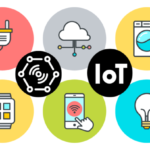Radio-frequency identification (RFID) is a technology that uses communication via electromagnetic waves to exchange data between a terminal and an electronic tag attached to an object, for the purpose of identification and tracking. Some tags can be read from several meters away and beyond the line of sight of the reader.
Phases of RFID Technology
- collecting data by managing the RFID-reader(s)
- enriching this collected data for further use (e.g. by filtering, accumulating, etc.)
- exchanging enriched data with backend-systems
Characteristics of RFID
- Able to Read and Write data without direct contact.
- With the adoption of space transmission technology and protocols, highly reliable communication is made possible.
- By “combining an item with its information”, a highly pliable and reliable system configuration becomes possible.
- Can simultaneously access information of multiple RF tags.
- Reading and writing is possible without line of sight, using electric and electromagnetic wave transmission.

RFID Tags
1. Passive Tags
Passive tags are small and cheap. They use the energy of the reader to respond which makes them readable over decades but results in a short reading range and bad reliability.
2. Active Tags
Active tags have a power source of their own, which results in larger reading range and good reliability. Their lifetime is limited by the lifetime of the power source.
3. Semi-Passive Tags
Semi-passive tags which have a battery but use the power of the reader to transmit messages. This results in good reliability but limited range. Another criterion for categorizing RFID tags is how they respond to readers. A tag that communicates with every reader is called promiscuous and one that needs some kind of authenticating, e.g. via password, is called secure.
Frequency bands use in RFID
There are four main frequency bands commonly in use:
- low frequency range (125 or 134.2 kHz)
- high frequency range (13.56 MHz)
- ultra high frequency range (UHF) (868 to 956 MHz)
- microwave frequency range (2.45 GHz or 5.8 GHz)
Advantages of RFID
- Forging is not easy
- No need to bring tag near reader
- Comparatively faster
- Can read multiple tags
- Expensive
- IS usually reusable within factory premises
Disadvantages of RFID
- RFID systems are often more expensive than barcode systems
- RFID technology is harder to understand
- Can be (debatably) less reliable
- RFID tags are usually larger than barcode labels
- Tags are application specific. No one tag fits all
- Possibility of unauthorized reading of passports and credit cards
- More than one tag can respond at the same time
Existing RFID Scenario : Live Tracking
Using RFID in Livestock Tracking and the resulting improvements The RFID technology is the next step to a solution of current problems in animal identification and tracking. With the RFID tags the first steps are taken to a more transparent backtracking, covering the entire chain from the producer tot he customer, and a centralized organization of animal data.
The vision is that all information about an animal and the owner it belongs to, is stored in a database. Records in the database do not only consist of the information to which owner an animal belongs to, but also if an animal changes its owner, every following owner, the complete track of an animal life and disease history and which particular breeding properties it has.
Summary
There are a variety of groups defining standards and regulating the use of RFID, including: International Organization for Standardization (ISO), International Electrotechnical Commission(IEC), ASTM International, DASH7 Alliance.
RFID has many applications; for example, it is used in enterprise supply chain management to improve the efficiency of inventory tracking and management.













[…] 3D and 4D Printing technology has its own pros and cons. Their usage depend upon requirement. They give additive effect of […]
[…] (frequency modulation) – in an FM transmitter, the modulation signal changes the frequency of the radio carrier […]